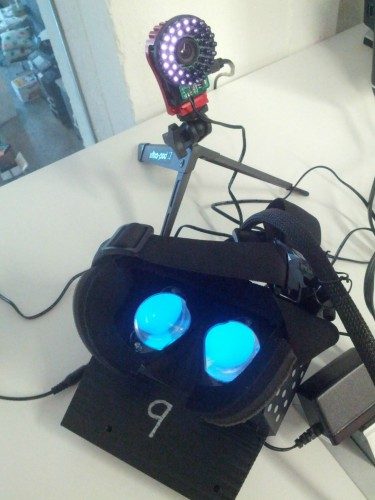As we reported a couple of days ago, a new version of Valve’s prototype VR Headset was demo’d at the recent VR Bender event in Boston. We noted the changes in tracking technology meaning the units are now seemingly much more portable.
Now, another user has posted their impressions along with another series of photos on the subreddit /r/oculus, this time with more detailed photos and information on the experience.
Reddit user ‘jonomf’ posted his detailed impressions and answers to questions from the Valve team demoing the kit. On the demos themselves, jononf has this to say:
We ran our jam project on the hardware a number of times, and also each got to run through Valve’s official demos. The demos were the same ones they run in “The Room”: a 3D grid of cubes showing webpages, a mirror showing your head as a cube, a tiny office of the 2D Portal people, the room full of pipes, a room with three of the robot playable characters from Portal 2 (one that’s your size, one tiny, one huge), one looking at a complex animated robot, and one where particles are constantly created a couple of feet in front of your face (thousands of serious DX11 compute particles with complex motion). All were very impressive; everyone I talked to agreed that the office full of Portal people was the most interesting: you really felt like a giant, and being able to bend down and hang out among them was very cool.
And in terms of the overall experience and how he felt post demo:
Needless to say, the experience in the HMD is amazing: low persistence, perfect tracking (within the camera of course), very high frame rate (they implored us to keep the jam games running at higher than 95 FPS). I don’t get sim sickness with the DK1 as it is, but nonetheless felt much more comfortable in the Valve units. However, I did consistently have major disorientation after leaving the HMD: I felt a little fuzzy and distant, and once felt like I was going to fall over. I felt something similar the very first time I came out of the DK1, never since, but every time after leaving the Valve units (4 or 5 times).
The assumption made up to now (and I include this website in that) is that these prototypes were the next generation of VR Headsets, moving on from the version shown to a limited audience at January’s Steam Dev Days event. However, it seems this is not the case. In fact, these units are working devices used by developers at Valve for convenience, any experiences developed using them still tested in the fiducial marker covered room at Valve HQ.
This is not a change of plans from The Room (as I saw someone speculate in another thread) — the Valve guys said that they each have one of these units on their desks for convenient VR testing, and then they load it up in the Room for primetime.
Technical details on the HMD and supporting software are also provided, seemingly the Valve operatives were extremely relaxed about offering information and images being taken during the demo:
The HMD’s are dual vertical S4 (OLED) screens, running a total of 2160×1280, with white IR-reflective dots on the shell. As you see in the pictures, the bottom ~half of the screen sticks out below the faceplate, so clearly you’re only seeing about half of it
We used a Unity plugin from Valve which is interoperable with DK1, DK2 (apparently), and the Valve hardware. The biggest end-user difference between this plugin and the Oculus Unity plugin that my team experienced is that the Valve plugin creates the stereo camera setup at runtime, so attaching gameobjects to the camera / using its forward vector / etc is slightly less trivial.
No DK2’s, or Oculus folks, to be had — word on the grapevine is that they decided they couldn’t afford the time off, as they’re busting ass getting DK2 to the rest of us. :)
An interesting note there about DK1 / DK2 interoperability alongside the Valve HMD. I do still wonder why it seems Valve are continuing to develop these prototypes (and by the sounds of it software to utilise / support the device) when impression up to now was that Valve’s VR R&D project was just that, Reseach and Development. Valve themselves have repeatedly stated that the device will never see the light of day commercially not to mention that a significant number of key players in the project (key among them Michael Abrash) have no left. What plans to Valve have for software derived from these prototypes?
Perhaps we’ll know more after this years E3 Expo, perhaps never. We’ll of course let you know should we find anything out. Thanks to /u/jononf for posting his detailed impressions and to /r/oculus for hosting them.


